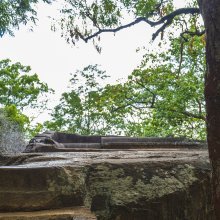Sabhamandapa, Sabha-mandapa, Sabhāmaṇḍapa: 8 definitions
Introduction:
Sabhamandapa means something in Hinduism, Sanskrit, the history of ancient India, Marathi. If you want to know the exact meaning, history, etymology or English translation of this term then check out the descriptions on this page. Add your comment or reference to a book if you want to contribute to this summary article.
Images (photo gallery)
In Hinduism
Shilpashastra (iconography)
Source: Archaeological Survey of India: Śaiva monuments at Paṭṭadakal (śilpa)Sabhāmaṇḍapa (सभामण्डप) or “audience hall”, is part of a sculpture in the first pillar of the southern half of the maṇḍapa of the temple of Lokeśvara.—Śiva and Pārvatī are in their sabhāmaṇḍapa (“audience hall”), surrounded by their attendants, sages and as usual, semi-celestial figures, eulogizing the divine couple. By the side of Śiva is seated Gaṇeśa and near the foot of Pārvatī is another seated figure. Probably, it is Skanda or Kumāra, their son. Usually, Skanda is shown by the side of Pārvatī, while Gaṇeśa is seated next to Śiva.
The whole scene looks very pacific like in a drama with happy end. All personages look as if relieved of their worries. It is likely that it represents the scene of the aftermath of the killing of Tārakāsura by Skanda. So the sages and others have come to honor the Divine family. In other words, it symbolizes the sukhānta “happy end” of the play, as prompted in the Nāṭyaśāstra by sage Bharata. In the topmost portion of the pillar is again a fighting scene. But this time the fighters are on elephants.

Shilpashastra (शिल्पशास्त्र, śilpaśāstra) represents the ancient Indian science (shastra) of creative arts (shilpa) such as sculpture, iconography and painting. Closely related to Vastushastra (architecture), they often share the same literature.
India history and geography
Source: Cologne Digital Sanskrit Dictionaries: Indian Epigraphical GlossarySabhā-maṇḍapa.—(HA), same as raṅga-maṇḍapa. Note: sabhā-maṇḍapa is defined in the “Indian epigraphical glossary” as it can be found on ancient inscriptions commonly written in Sanskrit, Prakrit or Dravidian languages.

The history of India traces the identification of countries, villages, towns and other regions of India, as well as mythology, zoology, royal dynasties, rulers, tribes, local festivities and traditions and regional languages. Ancient India enjoyed religious freedom and encourages the path of Dharma, a concept common to Buddhism, Hinduism, and Jainism.
Languages of India and abroad
Marathi-English dictionary
Source: DDSA: The Molesworth Marathi and English Dictionarysabhāmaṇḍapa (सभामंडप).—m (S) A portico or an erection in front of a temple where people assemble. 2 The open space of a temple in front of the gābhārā or apartment of the idol. 3 An audience-hall; a council-chamber; an assembly-room generally.
Source: DDSA: The Aryabhusan school dictionary, Marathi-Englishsabhāmaṇḍapa (सभामंडप).—m An erection in front of a temple. An audience-hall.
Marathi is an Indo-European language having over 70 million native speakers people in (predominantly) Maharashtra India. Marathi, like many other Indo-Aryan languages, evolved from early forms of Prakrit, which itself is a subset of Sanskrit, one of the most ancient languages of the world.
Sanskrit dictionary
Source: DDSA: The practical Sanskrit-English dictionarySabhāmaṇḍapa (सभामण्डप).—an assembly hall.
Derivable forms: sabhāmaṇḍapaḥ (सभामण्डपः).
Sabhāmaṇḍapa is a Sanskrit compound consisting of the terms sabhā and maṇḍapa (मण्डप).
Source: Cologne Digital Sanskrit Dictionaries: Cappeller Sanskrit-English DictionarySabhāmaṇḍapa (सभामण्डप).—[substantive] assembly-hall.
Source: Cologne Digital Sanskrit Dictionaries: Monier-Williams Sanskrit-English DictionarySabhāmaṇḍapa (सभामण्डप):—[=sabhā-maṇḍapa] [from sabhā] m. an assembly-hall, [Vāsavadattā]
Sanskrit, also spelled संस्कृतम् (saṃskṛtam), is an ancient language of India commonly seen as the grandmother of the Indo-European language family (even English!). Closely allied with Prakrit and Pali, Sanskrit is more exhaustive in both grammar and terms and has the most extensive collection of literature in the world, greatly surpassing its sister-languages Greek and Latin.
Nepali dictionary
Source: unoes: Nepali-English DictionarySabhāmaṇḍapa (सभामण्डप):—n. a stage;
Nepali is the primary language of the Nepalese people counting almost 20 million native speakers. The country of Nepal is situated in the Himalaya mountain range to the north of India.
See also (Relevant definitions)
Partial matches: Mandapa, Sabha.
Query error!
Full-text: Sabhamandap, Balani, Devarukhi, Gabhara, Bhangasala, Rangamandapa, Balanaka, Rupanarayana, Ablur.
Relevant text
Search found 10 books and stories containing Sabhamandapa, Sabha-mandapa, Sabhā-maṇḍapa, Sabha-mandapas, Sabhāmaṇḍapa; (plurals include: Sabhamandapas, mandapas, maṇḍapas, mandapases, Sabhāmaṇḍapas). You can also click to the full overview containing English textual excerpts. Below are direct links for the most relevant articles:
Sanskrit sources of Kerala history (by Suma Parappattoli)
The Sucindram inscription of Martandavarma (Dated Kollam 586) < [Chapter 1 - Historical details from Sanskrit Inscriptions]
Vastu-shastra (Introduction to Indian architecture) (by D. N. Shukla)
Chādya-prāsādas and Sabhā-maṇḍapas (Flat-roofed and Hall-temples) < [Chapter 12 - History of Hindu Temples (Prāsādas and Vimānas)]
(v,4) Vāstu in Kauṭilya’s Arthaśāstra < [Chapter 4 - An outline History of Hindu Architecture]
Temples of Rajasthana and Central India < [Chapter 12 - History of Hindu Temples (Prāsādas and Vimānas)]
The Structural Temples of Gujarat (by Kantilal F. Sompura)
4.16. Temples built during the reign of Bhima II (A. D. 1178-1242) < [Chapter 4 - Structural temples of the Caulukyan period (942-1299 A.D.)]
Chapter 8 - The Ground plan of the Mandapa (attached halls) < [Part 2, Section 3: The Architectural Canons]
2.2. The Siva temple of Sarnal < [Chapter 4 - Structural temples of the Caulukyan period (942-1299 A.D.)]
Garga Samhita (English) (by Danavir Goswami)
Verse 5.7.5 < [Chapter 7 - The Killing of Kuvalayāpīḍa]
Verse 2.25.12 < [Chapter 25 - The Rāsa-dance Pastime]
Verse 1.10.16 < [Chapter 10 - Description of the Birth of Lord Balarāma]
Sripura (Archaeological Survey) (by Bikash Chandra Pradhan)
Svastik Vihara < [Chapter 2 - The Architectural Panorama]
Ananda-Prabha-Kuti-Vihara < [Chapter 2 - The Architectural Panorama]
Siva Temples at Sripura (Introduction) < [Chapter 2 - The Architectural Panorama]
Later Chola Temples (by S. R. Balasubrahmanyam)
Temples in Tiruppulivanam < [Chapter II - Temples of Kulottunga I’s Time]
